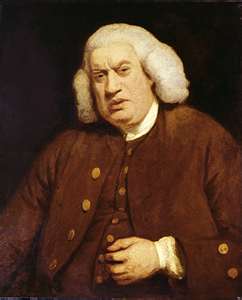Perhaps best remembered for his exceptional contributions to the study of Shakespeare, George Steevens was also an incredible collector of books. His enthusiasm for Elizabethan literature led him to build an amazing collection, which also included a number of William Hogarth prints. After Steevens’ death in 1800, his library was sold. A significant portion went to the British Museum. But among his contemporaries, George was equally well known for his literary pranks–which did little to endear him to his colleagues.
Shakespeare Scholarship
Steevens’ first published works on Shakespeare were 49 notes to Samuel Johnson’s 1765 edition of Shakespeare’s works. He strongly believed in preserving the quarto editions of Shakespeare, and soon published Twenty of the plays of Shakespeare, being the whole number printed in quarto during his life-time, or before the restoration, collated where there were different copies, and published from the originals. Johnson was so impressed with Steevens’ work, he suggested that Steevens undertake the entirety of Shakespeare’s works.

Samuel Johnson
That edition, The plays of Will Shakespeare (1773), was ten volumes long and took six years to publish. Though Johnson had contributed to the book only minimally, Steevens lionized his involvement to bolster sales. The edition was received quite well, though later it was discovered that Steevens had borrowed generously from Edward Capelli’s 1768 edition. Steevens and Isaac Reed published an updated edition in 1778. Reed undertook a third edition in 1785, but Steevens, who considered himself a “dowager” editor by this time, had little to do with the project. He resumed involvement only because of his resentment for rival editor Edmond Malone.
Steevens’ Hoaxes and Exploits
For all Steevens’ scholarship, he earned the nickname “Puck of Commentators” for his mischievous pranks. This was certainly a gentle assessment; Steevens executed some exceptional pranks. For his first (mis)deed, Steevens forged a letter from George Peele, recounting his meeting with Shakespeare and other dramatists at the Globe Theatre. Everyone accepted the letter as genuine, and it even appeared in Dr. John Berkenhout’s Biographia litteraria (1777).
Later Steevens decided to exact revenge on Richard Gough, a well known antiquarian against whom Steevens held a grudge. Gough refused to trade his Hogarth plates for some of Steevens’ rare books. Steevens had a large marble block engraved with an Anglo-Saxon inscription and the name “Hardecanute.” The tombstone was displayed in a Southwark shop, and Steevens circulated the story that the headstone had been discovered in Kennington. The faux artifact gleaned a write-up in Gentlemen’s Magazine (1790), and it was Steevens himself who revealed the forgery.
Even accomplished biologist and botanist Erasmus Darwin was taken in by Steevens’ ploys. In the December 1783 issue of London Magazine, Steevens published a description of the invented upas tree of Java, which could kill all other life within 15 to 18 miles. He based his account on the reports of an invented Dutch traveler. Darwin accepted the account and included it in his 1789 Loves of the Plants.
The Other Side of the Coin
Though Steevens obviously loved a good prank, he also helped to expose some of the most notorious forgers of his era. When Samuel Ireland announced that his son William Ireland had discovered a treasure trove of Shakespeare manuscripts. Steevens was quick to criticize the “discovery” and declare the Ireland editions to be forgeries. He also played an important part in exposing the Chatterton-Rowley forgeries.
Meanwhile Steevens was also known for his generosity–sometimes helping the family members of his own rivals. He assisted the family of author Oliver Goldsmith and many others. Ultimately these acts mitigated Steevens’ peers’ evaluation of him. Now he’s remembered not for these hoaxes, but for his scholarship and bibliography.


